The screech owl has a scientific name called Megascops and it’s a beautiful bird with a large head, a yellow beak, large yellow eyes, and white eyebrows. It has tufts of feathers at the top of its head that makes it look like horns are sticking out. It also has feathered toes as well.
Screech owls typically have two different types of colors within their feathers. They are either predominantly white and gray or white and red, depending on the section of the United States that they happen to live in.
Would you like to learn as much as you can about screech owls? I’ll share a plethora of information about these beautiful birds below. I’ll include:
- The easiest way to identify a screech owl
- Differences between female and male screech owls
- Fun and interesting facts
- Behavioral habits, dietary preferences, nesting habits, feeding habits, and migratory habits
- Other interesting facts and tidbits
Continue below to learn more about these creatures and their habits and preferences.
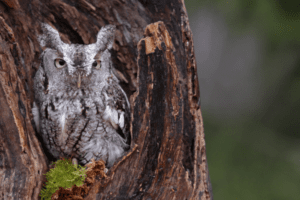
Screech Owl Bird Facts
- Common Name: Screech Owl
- Scientific Name: Megascops
- Scientific Family: Strigidae
- Life Span: 13-19 years
- Size: 7.4-10.0 inches
- Wingspan: 6.6-6.9 inches
- Weight: 5.8-6.5 ounces
- Conservation status: Least Concern
How To Identify A Screech Owl
There are some differences between the Western and Eastern screech owls to differentiate between the two. Typically, the Eastern species have brown, red, or gray colors mixed in with their feathers. And their backs typically contain darker bars of color. Plus, they have small tufts at the top of their head plus a yellow bill.
Western screech owls, on the other hand, have very similar luck except they’re always gray. Instead of a yellow bill, their bill is dark gray, and their head is more square than round. Now
Differences Between Male & Female
As for the Eastern screech owl, males are typically smaller in size than females. And the smaller the bird, the more agile flier. The male Eastern screech owls are also the hunters of the group. The female will hunt as long as she is not nesting. While nesting, the male will bring food to feed the female and her chicks. Males tend to have deeper voices than females as well.
For the Western screech owl, the males typically have brighter-looking feathers and colors than females. On average, the females are the larger of the group and they tend to way more than their male counterparts. Females typically have larger wingspans than their male counterparts.
Differences In Summer Plumage vs Winter Plumage
There are no marked changes in plumage colors of Eastern screech owls and Western screech owls during different seasons.
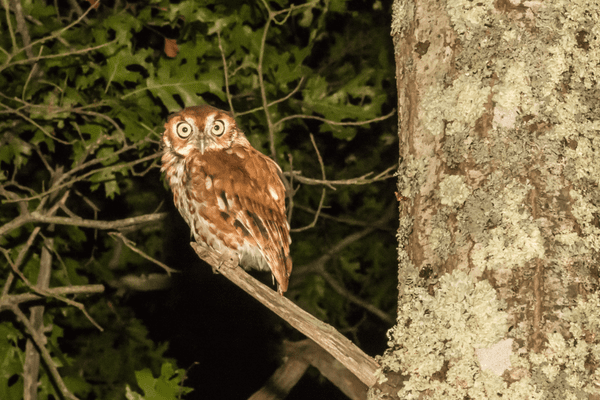
Where You’ll See Screech Owls
The Eastern screech owl is easy to find in the suburbs, and parks, and many other places to the east of the Rocky Mountains. They typically like to spend their time in areas where there are lots of trees, but they have no trouble nesting in backyard nesting boxes as well.
The Western screech owl, on the other hand, spends all of its time in the western part of North America, a large portion of Canada, some of Mexico, Southeast Alaska, Texas, and even large portions of Central America.
Screech Owl Migration Patterns
Technically speaking, Eastern and Western screech owls do not migrate. They maintain certain habitats that they like to establish below 5000-foot elevation. Western screech owls never migrate either, but it is possible that they will move short distances into northern areas.
Check out our handy map to get a better view of these owl breeding ranges and territories.
Diet and Feeding Preferences
According to the National Audubon Society, both Eastern and Western screech owls share a very similar diet. They tend to eat large insects and small mammals. Their diet will vary depending on the region or their particular habitat.
The small mammals they tend to consume include pocket gophers, voles, and mice. The insects that they usually eat include centipedes, scorpions, moths, spiders, and beetles.
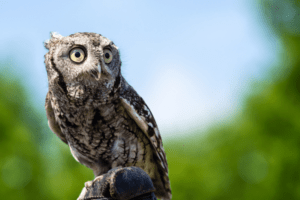
Screech Owl Nesting Facts
- Clutch Size: 4-6 eggs
- # of Broods: 1 brood
- Incubation Period: 29-31 days
- Nestling period: 26-30 days
- Egg Description: White
These creatures like to breed in early spring or late winter. They do not build their nest but usually take over an old woodpecker hole, a hollow stump, and they are even partial to man-made nesting boxes. If you do decide to build an owl box, it’s best to cover the bottom floor with sawdust. Even more important, these owls tend to nest 15 to 20 feet off the ground, so make sure your nesting box is at this height in the trees.
Screech Owl Behavior
Eastern screech owls have very specific behaviors that they repeat over and over again throughout their lives. They include:
- Nocturnal creatures that typically hunt at night but occasionally hunt at dusk, dawn, or in daylight
- Versatile hunters that have patience. They sit and wait for their prey to come to them before they pounce.
- Their flights are short and typically last for 75 feet or less.
- While flying between purchases, they tended to travel using a U -shaped pattern by dropping, then flying straight, and then rising again
- Male screech owls defend their territories
- Male screech owls are the hunters while nesting, but females will also hunt when they aren’t nesting
- Young Eastern screech owls depend on mom and dad for food for roughly 8-10 weeks after the fledgling stage
Very common behaviors of the Western screech owl include:
- Western screech owls are nocturnal creatures who hunt and far edge from sunset to a half hour before sunrise
- These birds are considered socially monogamous creatures, which means male and female Western screech owls will raise their young together
- Even though they are socially monogamous, male and female owls will occasionally meet outside of the pair
- Male and female of this species guard their nest during the nesting period to protect their brood from Jays, crows, and additional predators
- Female Western screech owls remain with their young at all times during the first three weeks, to begin taking breaks for hunting afterward
- Young owlets still remain near their parents for five weeks after leaving the nest
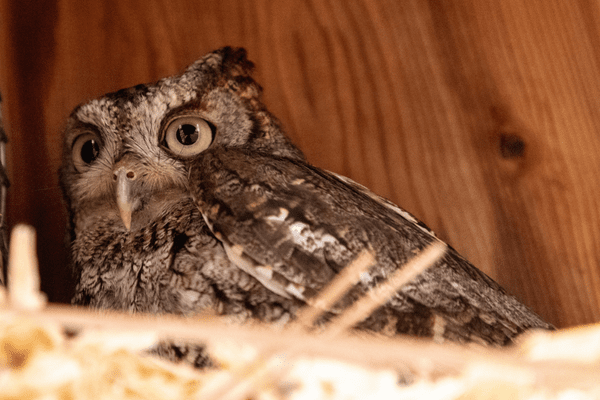
Tips for Birdwatchers On How To Attract Screech Owls
It’s relatively easy to attract these owls to your backyard. Simply try the following suggestions and you should attract them relatively quickly:
- Add a nesting box to your backyard. Make sure it’s between 20 to 30 feet off the ground
- Add a large birdbath to your backyard and keep it within 100-200 feet of the nesting box
- These birds love gnarled, dense trees, so plant them in your backyard and you’ll eventually have a great payoff many years from now
- Try not to mow the lawn or prune your branches too often because it creates more appealing hunting ground for screech owls
- Keep outdoor floodlights out of your backyard because they will likely scare away potential screech owls willing to nest in your nesting box
Conservation Status
The Eastern and Western screech owls are both considered Least Concern. This means there’s still a relatively large population of these owls present in the United States and parts of Canada and Mexico. Although, Eastern screech owl populations are slowly beginning to diminish, but it isn’t a major concern yet.
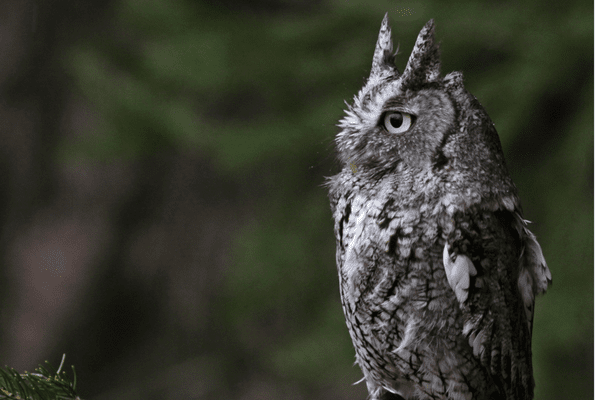
Fun & Interesting Facts
- Screech owls do not have around eyes. Their eyes are in more of a cylindrical shape. This gives them the ability to see with excellent clarity in the dark. Since they do not have around eyes, they cannot roll their eyes within their eye sockets.
- Screech owls have a total of 14 vertebrae in their necks. This is twice as many vertebrae as there are in the human neck. It allows them to turn their head 270°, or three-quarters of the way around.
- Out of all of the owls in North America, screech owls of the smallest.
- Screech owls have the ability to hide in trees because their plumage access camouflage and it blends in very well with the bark.
- Screech owls eat their meals hole, but they will often regurgitate under adjustable parts of their meals including fire, feathers, and bones in the form of a small pellet.
- Both Western and Eastern screech owls are fantastic hunters and they can catch and eat just about anything. They even catch large prey bigger than their body from time to time and they will eat a wide range of prey including rabbits, robins, crayfish, voles, worms, and small insects and mammals.
- Eastern and Western screech owls both nest in nesting boxes or tree cavities. Western screech owls can be found nesting in cavities located within large cactuses. Eastern screech owls are often found nesting within cavities of cottonwood trees.
Explore More Species in This Family
- White Throated Screech Owl
- Koepcke’s Screech Owl
- Eastern Screech Owl
- Western Screech Owl
- Pacific Screech Owl
- Balsas Screech Owl
- Middle American Screech Owl
- Rufescent Screech Owl
- Chocó Screech Owl
- Bearded Screech Owl
- Cloud Forest Screech Owl
- Tropical Screech Owl
- Black Capped Screech Owl
- Santa Marta Screech Owl
- Cinnamon Screech Owl
- Tawny Bellied Screech Owl
- Alagoas Screech Owl
- Whiskered Screech Owl
- Bare Shanked Screech Owl
- Yungas Screech Owl
- Vermiculated Screech Owl
- Long Tufted Screech Owl
- West Peruvian Screech Owl
- Xingu Screech Owl
- Foothill Screech Owl
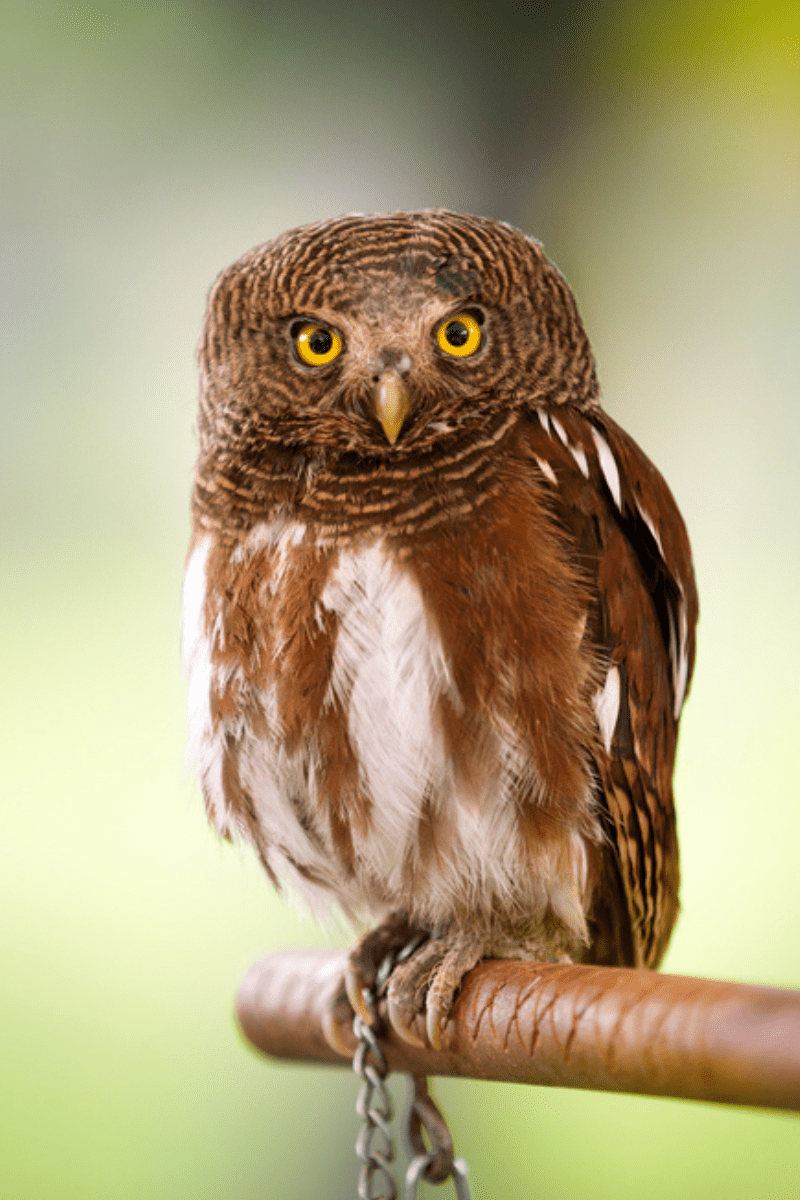
from BirdInformer.com https://ift.tt/Gaobexn

No comments:
Post a Comment